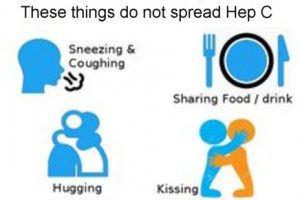Hep C Transmission
Hep C Transmission
How is Hepatitis C Transmitted?
Whilst Hep C is easily transmitted by blood to blood contact between two or more people it can not be transmitted any other way. For Hep C transmission there must be blood involved, infected blood must gain access to the bloodstream of a non-infected person for Hep C to be transmitted.
The Myths about Hep C Transmission
There are a lot of myths about Hep C transmission. The biggest myth is that Hep C can be transmitted through sex.
Because blood must connect with blood it means that Hepatitis C cannot be transmitted by any means where there is no blood. So, for example, Hep C cannot be transmitted from one person to another by touching, kissing or hugging. Likewise, Hep C cannot be transmitted by sneezing or coughing. Hepatitis C cannot be caught by sharing food, crockery, cutlery, towels, bathrooms or toilets. There is no need to wash your clothes separately.
One of the biggest myths about Hepatitis C is that Hep C is a sexually transmitted disease. It is almost impossible to catch Hep C through normal heterosexual sex, I know many, many heterosexual people who have been in relationships of 30 years or more where one partner has Hep C and the other partner does not and the Hep C has not been transmitted between them.
However anal sex does involve a significant risk of Hep C transmission so gay men are of particular risk of catching Hep C through anal sex. This is because of likely bleeding in the anal tissues and even the smallest graze or tear in the skin of the penis which will allow blood to blood contact.
So how does one catch Hep C?
Hepatitis C is a virus that lives in the blood and breeds in the cells of the liver. Hepatitis C is transmitted when infected blood from one person gets into someone else’s blood via a cut or even a tiny scratch. The Hep C virus is incredibly small, so small that even an electron microscope has trouble seeing it. One drop of blood can contain more than 10 million Hep C virus particles which means that microscopic amounts of blood can carry a large number of Hep C virus particles. It only requires just one single Hep C virus particle to enter your bloodstream to cause an infection. The Hep C virus replicates very fast and one virus can turn into millions within a very short space of time.
 SHARING OR REUSING OTHER PEOPLE’S NEEDLES AND SYRINGES.
SHARING OR REUSING OTHER PEOPLE’S NEEDLES AND SYRINGES.
Sharing needles or syringes is probably the highest risk activity for catching Hep C. This is because the needle enters the bloodstream directly and even a few molecules of the infected blood being carried on the needle will be enough to cause an infection. Many people who have only briefly experimented with intravenous drugs may find that they are infected with Hepatitis C. If you have ever used intravenous drugs you absolutely should get a Hepatitis C antibody test. This is a cheap test with an almost immediate result. Click here for more information on the Hep C antibody test.
TATTOOS, BODY PIERCING, AND OTHER COSMETIC PRACTICES.
Tattooing and body piercing are a risk if the equipment is not thoroughly sterilized. Like needles, tattooing and body piercing equipment could have come in contact with infected blood. If infected equipment isn’t sterilised properly, it can easily spread the virus to another person. If you have had a tattoo in prison or had tattoos or body peircing done by a person you are not confident about then you should get tested.
Another way that Hepatitis C is transmitted is through manicures and pedicures. The reason for this is that tiny amounts of infected blood can get onto the manicuring tools and spread from person to person very easily.
DENTAL, SURGICAL, AND MEDICAL PROCEDURES
In some countries the blood used for transfusions is not properly screened for hep C. Also, surgical and dental equipment is sometimes not well sterilized, which means there’s a risk it may still have very small amounts of the hep C virus on it and can infect other people. In most countries in the 21st century, the blood used for transfusions has been screened for hep C since the mid-1990s and is very safe. But there is always a risk that some procedures involving blood may be performed by workers who do not have a good understanding of the sterile procedure and infection control.
SHARING OF DRUG SNORTING EQUIPMENT.
When people use a straw for sniffing a drug, the lining inside the nose can easily be damaged and small amounts of blood can get onto the straw. If the straw is passed to another person to use, this blood (which may have the virus in it) can get in the second person’s bloodstream if the straw damages their nasal lining as well.
SEX
As mentioned above hepatitis C is not transmitted by normal sexual activities. Hepatitis C is not classified as a sexually transmissible infection (STI) and is not in vaginal fluids or semen. But there is a possibility of hepatitis C transmission if there are cuts or open wounds around the genital area of both people during sex.
PARENT TO BABY TRANSMISSION.
This is called Vertical Transmission and there is a low risk of hep C being passed on from mother to baby before or during birth. About 90% of babies born to hep C-positive mothers will not have hep C.
Fathers who have Hepatitis C cannot pass the virus on to their babies either when the baby is conceived, or during pregnancy.
SHARING OF PERSONAL HYGIENE ITEMS
Hep C can be transmitted through the use of such things as share razor blades, tweezers, and toothbrushes. Brushing your teeth can cause bleeding gums, so sharing your toothbrush can cause blood to blood contact. Razor blades and tweezers can also possibly lead to blood-to-blood contact between people.
NEEDLE-STICK INJURIES IN THE COMMUNITY
A needle-stick injury is an accidental injury from a needle containing another person’s blood. It can happen to medical staff in hospitals or surgeries, but also to members of the public who come across used syringes that have been thrown away in public places. If you suffer a needle stick injury the normal practice is to get a Hepatitis C antibody test about 4 weeks after receiving the needle stick injury.
OTHER PRACTICES THAT INVOLVE BLOOD
Traditional practices or rituals that involve direct blood-to-blood carry a very high risk of infection if one person has the hep C virus. Sharing instruments for branding or self-harming also carry a high risk of blood-to-blood contact


 SHARING OR REUSING OTHER PEOPLE’S NEEDLES AND SYRINGES.
SHARING OR REUSING OTHER PEOPLE’S NEEDLES AND SYRINGES. 